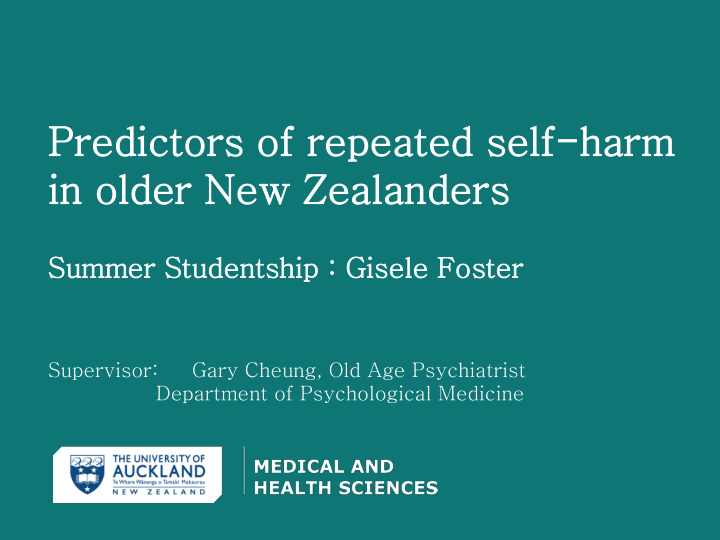



Predictors of repeate ted self-harm in in older New Zealanders Summer Studentship : : Gis isele Foster Supervisor: Gary Cheung, Old Age Psychiatrist Department of Psychological Medicine
Shah et al. (2015) Aging & Mental Health
Male Suicide Rates 2001 to 2010 NEW ZEALAND 60 50 Rates per 100,000 40 30 20 10 0 0- 5- 10- 15- 20- 25- 30- 35- 40- 45- 50- 55- 60- 65- 70- 75- 80- 85+ 5-year age group
Late-life Suicide: Risk Factors • psychiatric illness (particularly depression) • history of previous suicide attempts • physical illness • pain • functional impairment • social disconnectedness Cattell, 2000; Conwell and Thompson, 2008; Conwell et al., 2011; Fassberg et al., 2012
Suicidality: A continuum Death Suicidal Suicide Suicide Completed wish ideation Plan attempt suicide 28% 2-15.9% 11.5% Choi et al., 2015
9 to 18% older people who had made a suicide attempt would make further attempt within 12 months
Study: Aims (i) to characterise older suicide attempters in Auckland, Hamilton, Wellington and Christchurch; and (ii) to determine the predictors of repeat suicide attempt in 12 months.
Methods: Inclusion criteria • Age ≥ 65 • presented to ED following an episode of self-harm from 1st July 2010 to 30th June 2013 • 7 locations – Auckland City Hospital, North Shore Hospital, Waitakere Hospital, Middlemore Hospital, Waikato Hospital, Wellington Hospital and Christchurch Hospital
Methods: Databases (i) the existing electronic coding for “self - harm”, “suicide attempt”, “deliberate self - harm” in the emergency department and medical records department e.g. ICD10 Codes X60 to X84; (ii) the consultation-liaison referral database
Methods: Exclusion criteria • accidental self injury/overdose e.g. took the wrong medication purely by mistake • those who died from a suicide attempt (i.e. these cases are classed as suicide) • repeated episodes during the 3 years period
Methods: Classification of self-harm • The Columbia Classification Algorithm of Suicide Assessment (C-CASA) (Posner et al., 2007): (i) Suicide attempt (ii) Self-injurious behaviour, no suicidal intent (iii) Self-injurious behaviour, suicidal intent unknown
Summer Studentship Gisele Foster - To combine data from the 7 hospitals and perform statistical analysis - Learning included data management, SPSS, statistics, referencing, academic writing
Results: 1 • 339 older people (age 65-96; mean=74) • Female 55.2% • European 92.3% • Married 44.2%; widow 25.4% • Lived alone 38.1%
Results: 2 • Non-psychiatric hospital admission in previous 12 months: 46.9% • Past mental health history: 64.6% • Under MH service at time of self harm: 33.6% • Depression: 55.8% • Depressive symptoms: 17.7% • Past attempts: 34.2% • Positive blood alcohol: 14.2%
Results: 3 Suicide attempt 76.5% C-CASA Classification Self-injurious behaviour, 13.0% no suicide intent Self-injurious behaviour, suicide 10.3% intent unknown Methods Overdose 68.7% Laceration 9.1%
Acute stressors associated with self harm legal difficulties employment change financial trouble separation changed relationship/death of … family discord terminal illness in 1st degree … percieved physical illness death of 1st degree relative 0 20 40 60
Results: prognosis in 12 month 7 (2.1%) committed suicide 50 (14.7%) repeated self-harm
Results: repeat self-harm in 12 months Repeat Self-harm within 12 P-value Odds ratio months Yes No Under Mental 58% 29.4% 0.000 3.1 health* Past attempts 46% 32.2% 0.039 Taking 70% 46.4% 0.001 antidepressant Positive blood 28.0% 11.8% 0.003 3.5 alcohol* * Remained significant in final logistic regression model; Chi 2 =15.4, p=0.032, df=7, R 2 = 16.9%
Conclusion • Predictors of self harm: under mental health; positive blood alcohol • Role of physical illness in suicidal behaviour in older people • A very risk group – Suicide 2100 per 100,000 people • Suicide rate for the general older adult population = 6 to 19 per 100,000 people
Recommend
More recommend